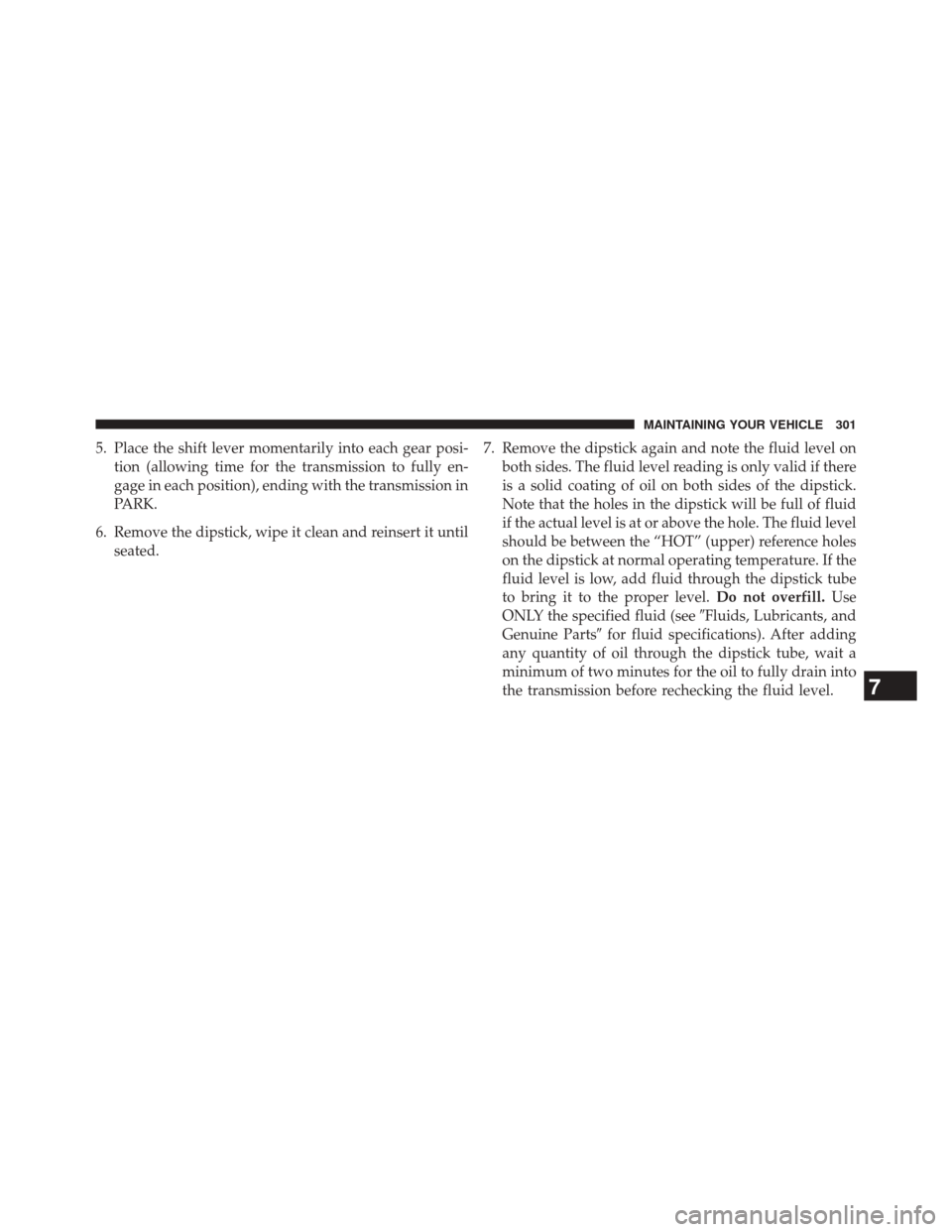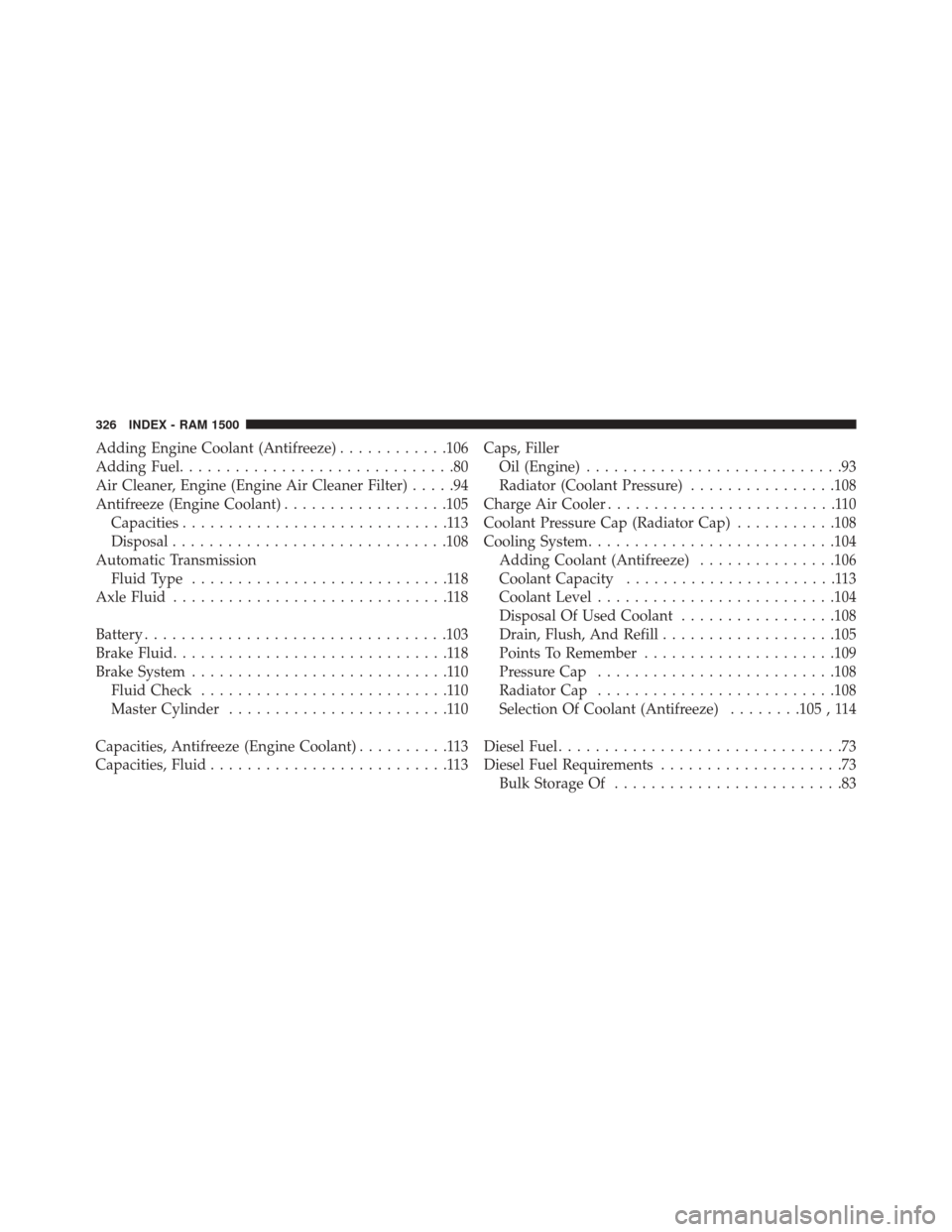Page 273 of 338

MAINTENANCE PROCEDURES
The pages that follow contain therequiredmaintenance
services determined by the engineers who designed your
vehicle.
Besides those maintenance items specified in the fixed
maintenance schedule, there are other components which
may require servicing or replacement in the future.
CAUTION!
• Failure to properly maintain your vehicle or per-
form repairs and service when necessary could
result in more costly repairs, damage to other
components or negatively impact vehicle perfor-
mance. Immediately have potential malfunctions
examined by an authorized dealership or qualified
repair center.
(Continued)
CAUTION! (Continued)
•Your vehicle has been built with improved fluids
that protect the performance and durability of your
vehicle and also allow extended maintenance inter-
vals. Do not use chemical flushes in these compo-
nents as the chemicals can damage your engine,
transmission, power steering or air conditioning.
Such damage is not covered by the New Vehicle
Limited Warranty. If a flush is needed because of
component malfunction, use only the specified
fluid for the flushing procedure.
Engine Oil
Checking Oil Level
To assure proper lubrication of your vehicle’s engine, the
engine oil must be maintained at the correct level. Check
the oil level at regular intervals. The best time to check
the oil level is before starting the engine after it has been
7
MAINTAINING YOUR VEHICLE 271
Page 303 of 338

5. Place the shift lever momentarily into each gear posi-tion (allowing time for the transmission to fully en-
gage in each position), ending with the transmission in
PARK.
6. Remove the dipstick, wipe it clean and reinsert it until seated. 7. Remove the dipstick again and note the fluid level on
both sides. The fluid level reading is only valid if there
is a solid coating of oil on both sides of the dipstick.
Note that the holes in the dipstick will be full of fluid
if the actual level is at or above the hole. The fluid level
should be between the “HOT” (upper) reference holes
on the dipstick at normal operating temperature. If the
fluid level is low, add fluid through the dipstick tube
to bring it to the proper level. Do not overfill.Use
ONLY the specified fluid (see �Fluids, Lubricants, and
Genuine Parts� for fluid specifications). After adding
any quantity of oil through the dipstick tube, wait a
minimum of two minutes for the oil to fully drain into
the transmission before rechecking the fluid level.
7
MAINTAINING YOUR VEHICLE 301
Page 316 of 338

MAINTENANCE SCHEDULE — DIESEL ENGINE
CAUTION!
Failure to perform the required maintenance items
may result in damage to the vehicle.
At Each Stop For Fuel
Check the engine oil level at least 30 minutes after a fully
warmed engine is shut off. Checking the oil level while
the vehicle is on level ground will improve the accuracy
of the oil level reading. Add oil only when the level is at
or below the ADD or MIN mark.
Once A Month
• Inspect the batteries, and clean and tighten the termi-
nals as required. •
Check the fluid levels of the coolant reservoir, brake
master cylinder, and automatic transmission (if
equipped), and add as needed.
At Each Oil Change
• Change the engine oil filter.
• Inspect the exhaust system.
• Inspect engine air filter.
• Check the coolant level, hoses, and clamps.
• Lubricate outer tie rod ends.
Inspection and service should also be performed anytime
a malfunction is observed or suspected. Retain all re-
ceipts.
Oil Change Indicator System — Cummins Diesel
Your vehicle is equipped with an engine oil change
indicator system. This system will alert you when it is
time to change your engine oil by displaying the words
314 MAINTENANCE SCHEDULE
Page 328 of 338

Adding Engine Coolant (Antifreeze)............106
Adding Fuel ..............................80
Air Cleaner, Engine (Engine Air Cleaner Filter) .....94
Antifreeze (Engine Coolant) ..................105
Capacities .............................113
Disposal ............................. .108
Automatic Transmission Fluid Type ............................118
Axle Fluid ..............................118
Battery ................................ .103
Brake Fluid ..............................118
Brake System ............................110
Fluid Check ...........................110
Master Cylinder ........................110
Capacities, Antifreeze (Engine Coolant) ..........113
Capacities, Fluid ..........................113 Caps, Filler
Oil (Engine) ............................93
Radiator (Coolant Pressure) ................108
Charge Air Cooler .........................110
Coolant Pressure Cap (Radiator Cap) ...........108
Cooling System .......................... .104
Adding Coolant (Antifreeze) ...............106
Coolant Capacity .......................113
Coolant Level ......................... .104
Disposal Of Used Coolant .................108
Drain, Flush, And Refill ...................105
Points To Remember .....................109
Pressure Cap ......................... .108
Radiator Cap ......................... .108
Selection Of Coolant (Antifreeze) ........105 , 114
Diesel Fuel ...............................73
Diesel Fuel Requirements ....................73
Bulk Storage Of .........................83
326 INDEX - RAM 1500
Page 330 of 338

Information Center, Vehicle...................25
Instrument Cluster .........................16
Intervention Regeneration Strategy ..............32
Keyless Enter-N-Go ........................65
Maintenance Procedures .....................91
Maintenance Schedule ..................... .120
New Vehicle Break-In Period ..................13
Oil, Engine ...............................92
Capacity ..............................113
Change Interval .........................93
Dipstick ...............................92
Disposal ..............................94 Filter
.............................94,114
Filter Disposal ..........................94
Materials Added To ......................94
Recommendation ........................92
Viscosity ..............................93
Radiator Cap (Coolant Pressure Cap) ...........105
Remote Starting System ......................12
Schedule, Maintenance .....................120
Selection Of Coolant (Antifreeze) ..............114
Starting .................................63
Automatic Transmission ...................64
Engine Block Heater ...................66,73
Remote ...............................12
Starting Procedures .........................63
Starting Procedures (Diesel Engines) .............63
328 INDEX - RAM 1500
Page 331 of 338
Tip Start................................64
Transfer Case Fluid ................................118
Transmission
Viscosity, Engine Oil ........................93
Voltmeter ................................68
Water Separator, Diesel Fuel ..................97
8
INDEX - RAM 1500 329
Page 332 of 338

Adding Engine Coolant (Antifreeze)............292
Adding Fuel ............................ .248
Air Cleaner, Engine (Engine Air Cleaner Filter) . . . .276
Air Filter .............................. .276
Antifreeze (Engine Coolant) ..................291
Capacities ........................... .308
Disposal ............................. .294
Automatic Transmission Adding Fluid ......................... .301
Fluid Level Check ...................... .300
Fluid Type ............................311
Shifting ............................. .222
Axle Fluid ..............................311
Battery ................................ .289
Blanket ...........................211,290
Emergency Starting ..................... .262
Brake System ........................... .296Fluid Check
.......................... .296
Master Cylinder ....................... .296
Brake/Transmission Interlock .................222
Capacities, Antifreeze (Engine Coolant) ..........308
Capacities, Fluid ......................... .308
Caps, Filler Oil (Engine) .......................... .274
Radiator (Coolant Pressure) ................294
Charge Air Cooler ........................ .296
Coolant Pressure Cap (Radiator Cap) ...........294
Cooling System .......................... .290
Adding Coolant (Antifreeze) ...............292
Coolant Capacity ...................... .308
Coolant Level ......................... .290
Disposal Of Used Coolant .................294
Drain, Flush, And Refill ...................291
Points To Remember .....................295
Pressure Cap ......................... .294
330 INDEX - RAM 2500 / 3500 / 4500 / 5500
Page 335 of 338

Noise Emission Warranty....................303
Oil Change Indicator ...................... .314
Oil, Engine ............................. .271
Capacity ............................ .308
Change Interval ....................... .273
Dipstick ............................. .271
Disposal ............................. .276
Filter ........................... .276 , 309
Filter Disposal ........................ .276
Identification Logo ..................... .273
Materials Added To ..................... .275
Recommendation ...................... .273
Synthetic ............................ .275
Viscosity ............................ .274
Overdrive .............................. .232
Overdrive OFF Switch ..................... .232
Perform Service Indicator, Reset ...............316Power
Take-Off Adapter ...................... .239
Take-Off Operation ..................... .239
PTO (Power Take-Off) ..................... .239
Radiator Cap (Coolant Pressure Cap) ...........291
Remote Starting System .....................138
Resetting Perform Service Indicator ............316
Selection Of Coolant (Antifreeze) ..............309
Shifting ............................... .220
Automatic Transmission ..................222
Manual Transmission ....................234
Speed Control Accel/Decel .......................... .147
Cancel .............................. .146
Speed Control (Cruise Control) ................144
Starting ............................... .196
Automatic Transmission ..................197
8
INDEX - RAM 2500 / 3500 / 4500 / 5500 333